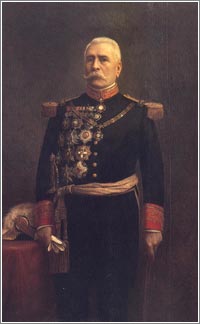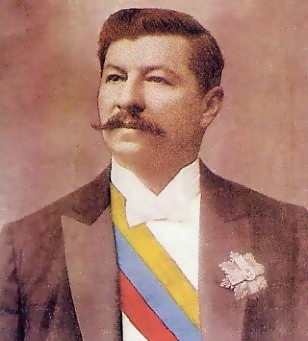Buenos dias, readers! Today I bring you some entertaining facts about the lives of four Latin American dictators, called caudillos by the locals. The caudillo usually begins as a military leader with a great charisma and generic promises of popular reforms. The best caudillos, as with any good dictator, build a cult of personality around themselves. Viva la revolucion!
José de la Cruz Porfirio Díaz (1830-1915), alias El 4th, 6th, e 8th Presidente. His rule known as the Porfiriato. Porfirio Díaz was dictator of Mexico from 1876 to 1911. Here's some interesting trivia about the man, the myth, the caudillo:
His political philosophy was Pan, o palo ("Bread, or the stick"), and he often walked the streets of Mexico City upon a whim, alternatively distributing loaves of bread or sound thrashings with his billiard cue.
A prodigious aphorist, he regularly stayed up late into the night jotting down pithy quotations, finally finding lasting fame with the popular ironic saying, "Poor Mexico, so far from God and so close to the United States!"
In a 1908 interview with the U.S. monthly political rag Pearson's Magazine, the 78-year-old Díaz casually mentioned that he felt that Mexico was ready for democracy and free elections, and he had thought of retiring to a life of sun-drenched leisure on the French Riviera. This comment started the decade-long Mexican Revolution -- best watch out, Fidelito!
In the 1910 election, octogenarian Díaz decided to not retire and ran again. To improve his election prospects, he imprisoned his opponent, Francisco I. Madero. He was almost unanimously reelected! But then all his opponents forced him into exile in France. :(
Generalissimo Rafael Leónidas Trujillo (1891-1961), alias El Jefe ("The Boss"), rule known as La Era de Trujillo. Rafael Trujillo was dictator of the Dominican Republic from 1930 until his 1961 assassination.
Trujillo built around himself a cult of personality. In 1936, he had Congress rename the capital, Santo Domingo, Cuidad Trujillo ("Trujillo City") in his honor, created a new province named "Trujillo," and christened the D.R.'s tallest mountain Pico Trujillo ("Mt. Trujillo") He also had a giant neon sign erected in Santo Domingo that read "God and Trujillo."
Before working as a dictator, Trujillo had jobs as a Morse code telegraph operator and a security guard at a sugar cane mill. Both skills came in handy as dictator.
Trujillo recruited some of the American Negro League's most famous stars, including Satchel Paige, to play on his personal baseball team, paying them handsomely to win the Dominican championship. Most fled the country after they found out how crazy he was.
He owned over two thousand suits and military uniforms, many of them blatant affronts to fashion.
A man known by many nicknames, El Jefe was also called, in various quarters, El Benfactor, El Chivo ("The Goat"), for his penchant for eating tin cans, and Chapitas ("Bottlecaps") for the many military medals he wore and dozen bottles of Coca-Cola he drank todos los dias.
Justifying his long authoritarian rule, Gómez said he "needed a lifetime to fulfill his political work." He later added that he also needed a lifetime to fulfill his desire for mistresses and oil money.
As most good dictators are, he was also functionally illiterate.
Happy 100th birthday, repressive authoritarian government!
Dr. José Gaspar Rodríguez de Francia (1766-1840), alias El Supremo, was dictator of Paraguay from its independence in 1814 to his death in 1840. Here are fun facts about his rule:
Dr. Francia insisted that he personally conduct all marriage ceremonies in Paraguay. This included the "animal marriages" between livestock he felt morally justified.
He made everyone raise their hats when he passed, and his hatless subjects had to carry fake hat brims to salute him properly. I'm not sure exactly what a "fake hat brim" is, but they evidently have them in South America.
A cat lover, he once ordered all dogs in his domain to be shot, in what later became known as the "Great Dog Massacre."
He appointed himself the Pope of Paraguay, seizing all the Roman Catholic Church's property and possessions, resulting in his excommunication. In a fit of anger on hearing the news, Francia excommunicated his favorite horse, Marcelito.
Paraguay's first public library, opened in 1836, consisted of the personal collections of his executed political opponents. Francia personally donated over a hundred copies of his self-published autobiography, My Way: How a Simple Country Doctor became Supreme Ruler of the Seventh-Largest Nation in South America.
A great fan of all things Rousseauian and Japonisme, Dr. Francia closed the borders of Paraguay to all outside cultural and economic contact from 1816 to his death.
Perhaps because of this cultural isolation, he wore a powdered wig long after it was out of fashion (see above stamp).
* * *
José de la Cruz Porfirio Díaz (1830-1915), alias El 4th, 6th, e 8th Presidente. His rule known as the Porfiriato. Porfirio Díaz was dictator of Mexico from 1876 to 1911. Here's some interesting trivia about the man, the myth, the caudillo:
His political philosophy was Pan, o palo ("Bread, or the stick"), and he often walked the streets of Mexico City upon a whim, alternatively distributing loaves of bread or sound thrashings with his billiard cue.
A prodigious aphorist, he regularly stayed up late into the night jotting down pithy quotations, finally finding lasting fame with the popular ironic saying, "Poor Mexico, so far from God and so close to the United States!"
In a 1908 interview with the U.S. monthly political rag Pearson's Magazine, the 78-year-old Díaz casually mentioned that he felt that Mexico was ready for democracy and free elections, and he had thought of retiring to a life of sun-drenched leisure on the French Riviera. This comment started the decade-long Mexican Revolution -- best watch out, Fidelito!
In the 1910 election, octogenarian Díaz decided to not retire and ran again. To improve his election prospects, he imprisoned his opponent, Francisco I. Madero. He was almost unanimously reelected! But then all his opponents forced him into exile in France. :(
* * *
"Rectitude, liberty, and work," evidently the formula for successful Dominican palm-tree farming.
Trujillo built around himself a cult of personality. In 1936, he had Congress rename the capital, Santo Domingo, Cuidad Trujillo ("Trujillo City") in his honor, created a new province named "Trujillo," and christened the D.R.'s tallest mountain Pico Trujillo ("Mt. Trujillo") He also had a giant neon sign erected in Santo Domingo that read "God and Trujillo."
Before working as a dictator, Trujillo had jobs as a Morse code telegraph operator and a security guard at a sugar cane mill. Both skills came in handy as dictator.
Trujillo recruited some of the American Negro League's most famous stars, including Satchel Paige, to play on his personal baseball team, paying them handsomely to win the Dominican championship. Most fled the country after they found out how crazy he was.
He owned over two thousand suits and military uniforms, many of them blatant affronts to fashion.
A man known by many nicknames, El Jefe was also called, in various quarters, El Benfactor, El Chivo ("The Goat"), for his penchant for eating tin cans, and Chapitas ("Bottlecaps") for the many military medals he wore and dozen bottles of Coca-Cola he drank todos los dias.
* * *
Gómez wearing his favorite Venezuelan-flag-themed sash.
General Juan Vicente Gómez (1857-1935), alias El Benemérito ("The Meritorious One"), dictator of Venezuela from 1908 to his death in 1935.
Gómez, then vice-president, seized power when President Cipriano Castro was in Europe getting medical treatment for a host of venereal diseases. He originally had been a member of Castro's private militia, which overthrew the Venezuelan government (not very difficult to do) in 1899.
Although he was never married, Gómez had a total of 15 children with his two primary mistresses, and perhaps as many as 70 other illegitimate children with other women. He naturally appointed many of his scions to public office. He made his son Guillermo "Minister of Merengue," for example.
Gómez, like Ronald Reagan, worked as a cowboy before making it in politics.
He was an almost full-blooded Indian, but this does not jive with his amazing mustache-growing ability.
For the last decade of his rule, he governed the country from his ranch Las Delicias, where, according to his Time obituary, "he sat under a giant rubber tree, feeding peanuts to his pet elephant, beaming fondly at his squalling, illegitimate offspring."
Gómez was also known as El Bagre ("The Catfish") because of his aforementioned prominent and pointed mustache. The name also might have referred to the giant indoor fish tank that the amateur marine biologist had installed in his mansion.
Justifying his long authoritarian rule, Gómez said he "needed a lifetime to fulfill his political work." He later added that he also needed a lifetime to fulfill his desire for mistresses and oil money.
As most good dictators are, he was also functionally illiterate.
* * *
Well, I hope you have enjoyed our little journey into the minds of los caudillos famosos. Look for a future installment with more fascinating and sometimes endearing tales of my favorite Latin American strongmen!





No comments:
Post a Comment